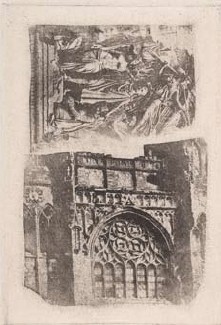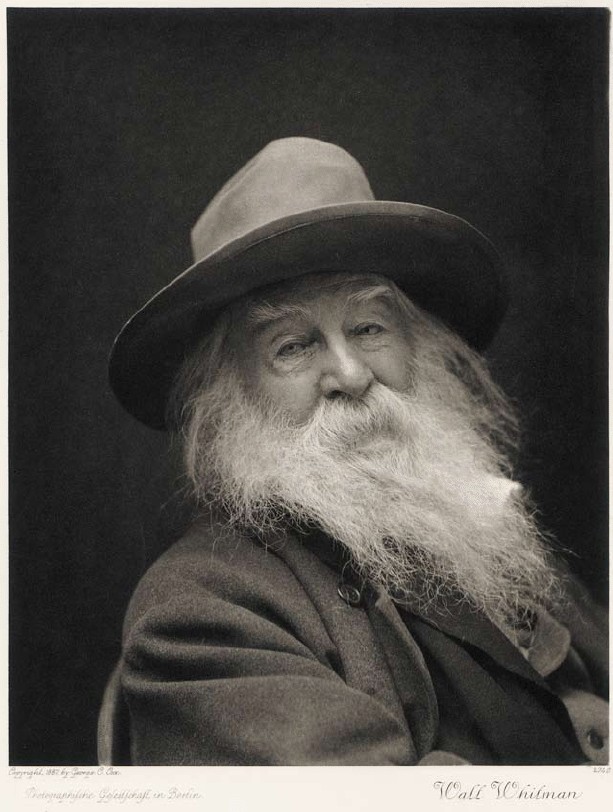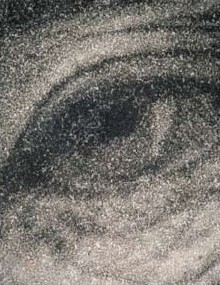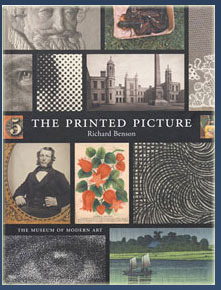- Relief printing
- Intaglio and planographic printing
- Color printing
- Bits and pieces
- Early photography in silver
- Non-silver processes
- Modern photography
- Color notes
- Color photography
- Photography in ink: relief and intaglio printing
- Photography in ink: planographic printing
- Digital processes
- Where do we go from here?
Flat-plate photogravure

Photolyphic engraving, irreg. William Henry Fox Talbot. Untitled. c. 1852. 2 5/16 x 3 7/16” (5.9 x 8.8 cm). The Museum of Modern Art, New York. Gift of the International Museum of Photography at George Eastman House. Many early attempts were made to print photographs with ink. This small experimental print, which Talbot called a “photoglyptic engraving,” was an attempt to make an intaglio reproduction of a pair of calotypes.
We leave relief printing now and move back in time to the adaptation of intaglio printing to the photographic image. The copper plate, dampened paper, etching press, and silky aquatint were all waiting in the wings for the invention of photography. If you believe, as I do, that photography was invented because the printing presses of the world needed more data than the hand could provide, then the early development of photogravure seems an inevitable step. By the 1880s photogravure had reached a state of near perfection, due to final refinements by Karl Klíc. The process combined all the tools of etching and aquatint with the tonal description of the photographic carbon print. Though the steps in making a gravure are complex, we can describe them quite easily, because we have previously described both aquatint and carbon printing.

Hand gravure. George C. Cox. Walt Whitman. c. 1887. 10 1/4 x 7 5/8" (26 x 19.4 cm). Printed by Photographische Gesellschaft, Berlin. The Museum of Modern Art, New York. Gift of Richard Benson. Photogravure is an intaglio process of great beauty, but it never became as common as letterpress halftone because it is expensive and requires specialized machinery.
A copper plate is polished, cleaned, and dusted with acid-resistant grains in exactly the same way as is done for a hand-drawn aquatint. A sheet of carbon tissue carrying a red pigment is sensitized to light in exactly the same way as the tissue for a carbon print. This tissue is then exposed to a film or glass-plate positive (instead of a negative), and the carbon/gelatin image is pressed to the aquatinted copper plate instead of to a sheet of receiver paper. Once the tissue is removed by development in hot water, the plate is dried and then etched, using a heavy solution of ferric chloride in water. This is where the magic takes place. The crucial ingredient in the resist now transferred over to the aquatinted copper plate is not the pigment but the gelatin.

Enlargement of Hand gravure. George C. Cox. Walt Whitman. c. 1887. 10 1/4 x 7 5/8" (26 x 19.4 cm). Printed by Photographische Gesellschaft, Berlin. The Museum of Modern Art, New York. Gift of Richard Benson. A seven-times enlargement showing the fine grain of the ink-bearing aquatint cells.
A carbon print consists of a gelatin layer that varies in thickness according to the values coming from its exposure. Because the gelatin layer now stuck to the aquatint was made from a positive rather than a negative, it is thin in the shadows of the picture and thick in the highlights. When placed in the etching bath the gelatin slowly takes up water and swells, and as it does so the ferric chloride is able to move through it. In the dark areas of the picture, where the gelatin is thin, the iron compound quickly reaches the copper and begins to etch the fine spots left open by the aquatint. The lighter values are etched later, after the necessary time has passed for the gelatin to swell and allow ferric chloride to pass through those areas. After the etch has reached all parts of the picture, it is stopped and the resist and aquatint are removed. The plate now carries a set of ink-bearing pits that have been etched for variable amounts of time in inverse proportion to the thickness of the gelatin layer that had been applied to the surface. This variable depth, when printed, lays down ink of variable thickness to generate tone. Because photogravure depends upon an ink film that varies in thickness to show tonal differences, it uses an ink that is less dense than that for other processes, where the requirement of the ink is to simply be as black as possible.

